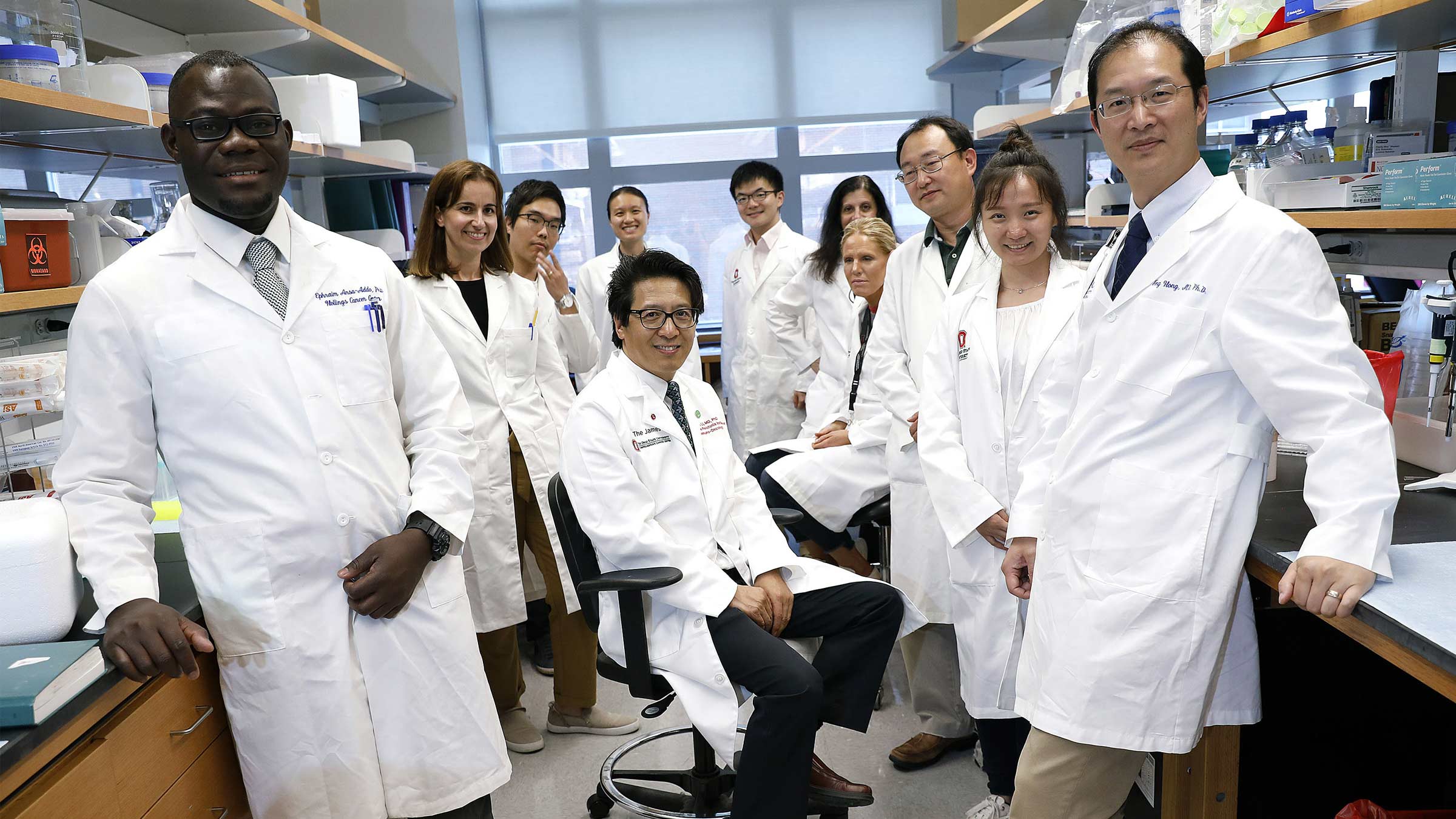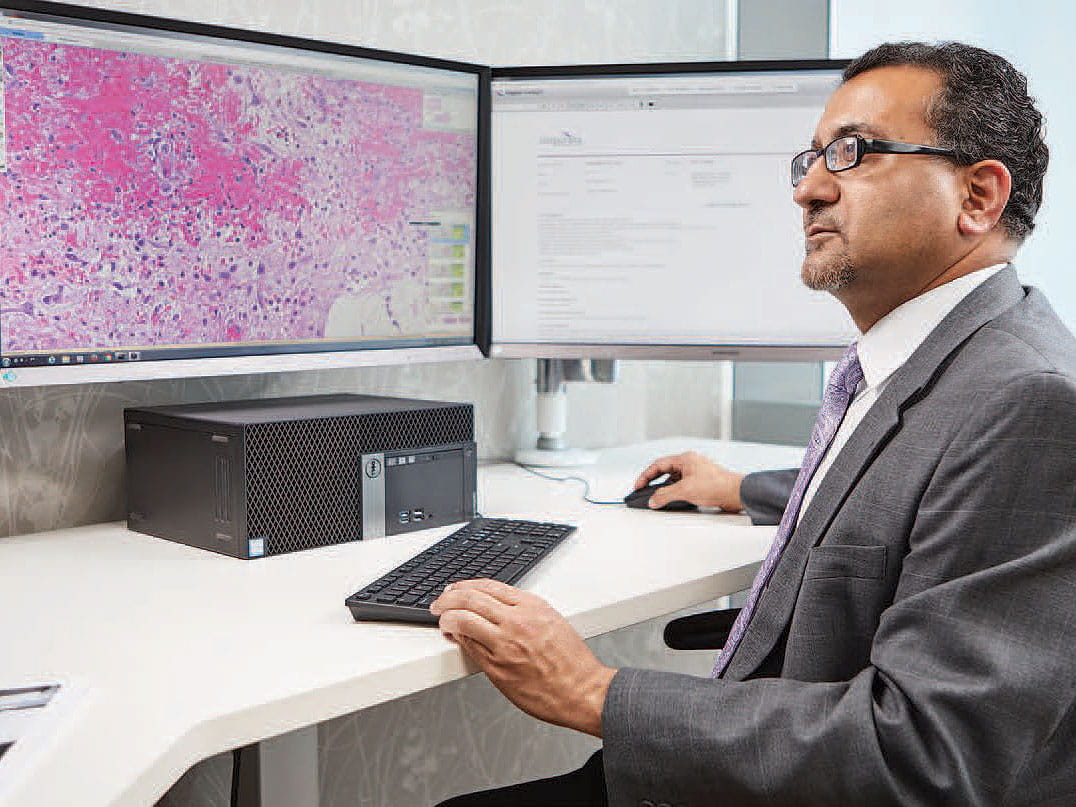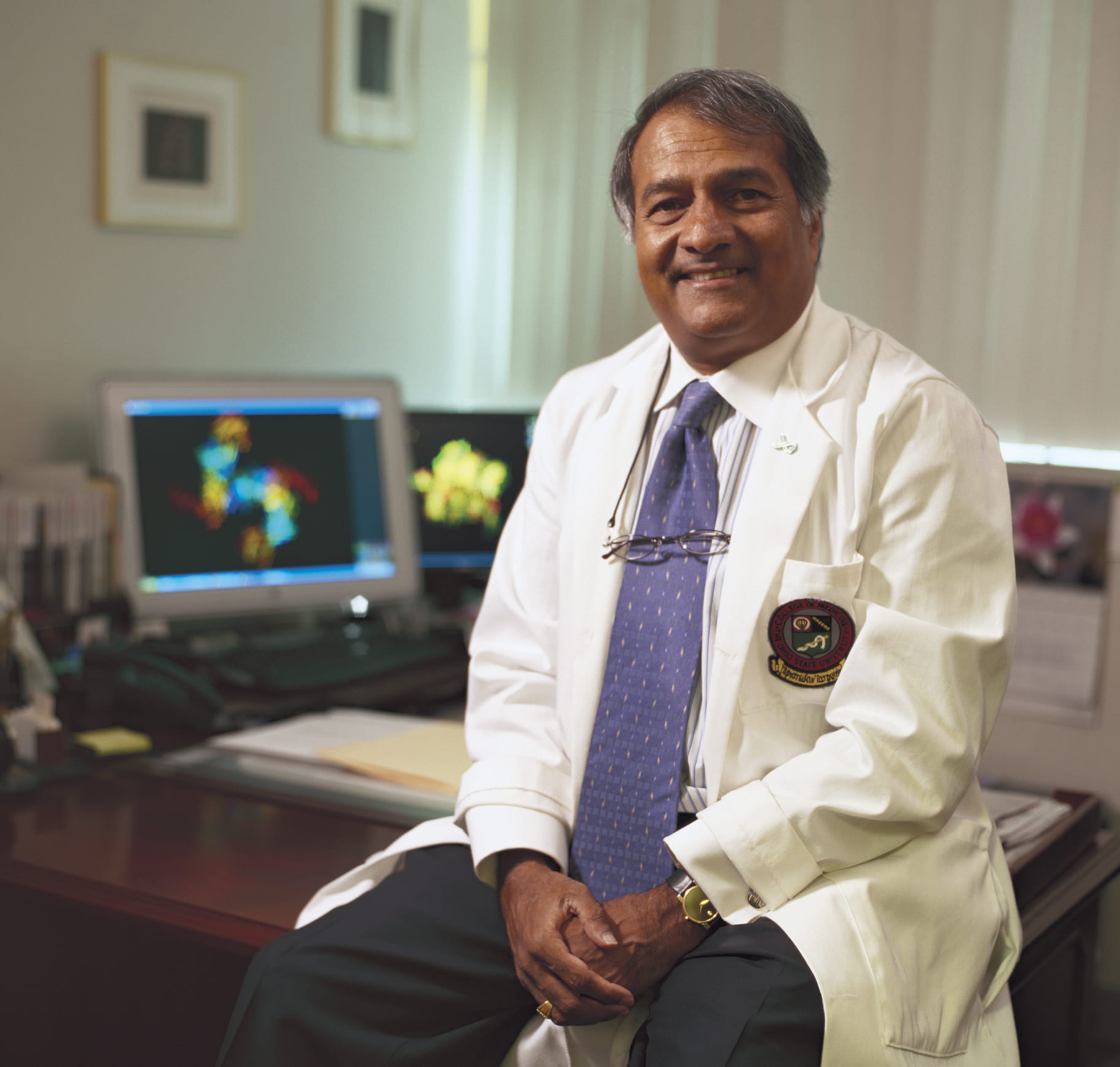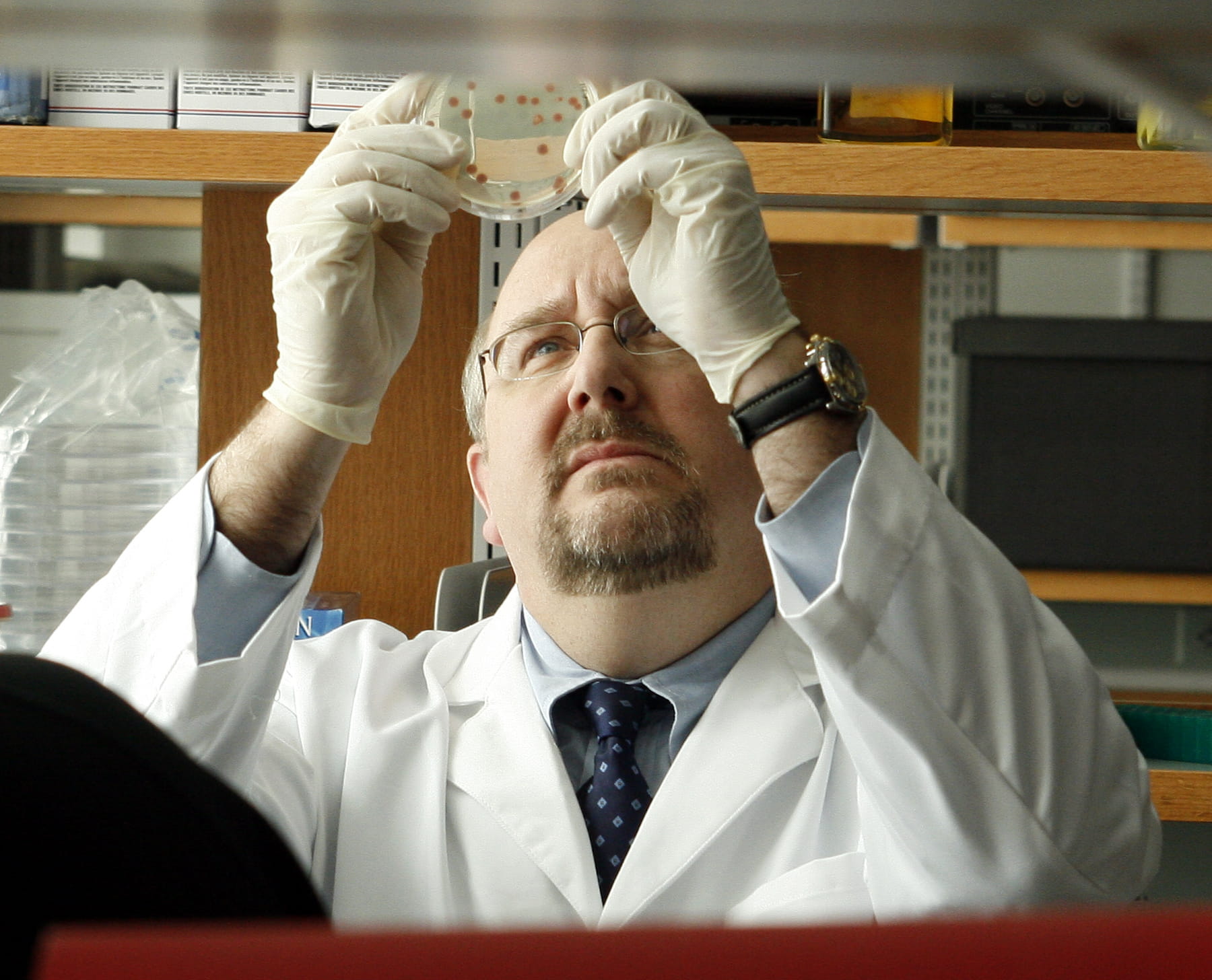
As leaders of Ohio State’s cancer program, OSUCCC Director Raphael Pollock, MD, PhD, FACS, and James CEO William Farrar, MD, can identify legions of ways that The Ohio State University has contributed to advances in science-based cancer care over the past 50 years. Here are a few:
 In 2017, the OSUCCC – James initiated a comprehensive Digital Pathology Program under the direction of Anil Parwani, MD, PhD, MBA, that will fully digitize anatomical pathology services using whole-slide imaging technology that scans entire glass pathology slides and converts them to digital images.
In 2017, the OSUCCC – James initiated a comprehensive Digital Pathology Program under the direction of Anil Parwani, MD, PhD, MBA, that will fully digitize anatomical pathology services using whole-slide imaging technology that scans entire glass pathology slides and converts them to digital images.
The system will provide fully automated end-to-end pathology workflow and a bank of ultra-fast scanners for digitizing current and past glass pathology slides.
The OSUCCC – James was the first cancer center in Ohio to offer chimeric antigen receptor T-cell (CAR T-cell) therapy, thanks to the work of Samantha Jaglowski, MD, MPH, and others. “To create these personalized therapies,” Farrar says, “T cells are removed from the patient, genetically altered to recognize cancer-specific antigens, grown to large numbers in the lab and then infused back into the patient to stimulate the immune system to attack cancer cells.” Jaglowski tested the breakthrough therapy in clinical trials that helped lead to its approval by the FDA for use in adults with advanced lymphoma.
And Ohio State is a leader in research and prevention efforts for lung cancer, the No. 1 cause of cancer-related death among both men and women, through the work of David Carbone, MD, PhD, director of the Thoracic Oncology Center; Greg Otterson, MD; and several others who are studying molecular mechanisms of the many lung cancer subtypes to guide the development of better therapeutics.
Some 80% to 90% of lung cancer cases stem from tobacco use. The OSUCCC – James has long been involved not only with smoking-cessation efforts, but with efforts to understand and intervene in tobacco use and its effects on negative health outcomes. These studies are being led or carried out by the work of OSUCCC Deputy Director Peter Shields, MD; Mary Ellen Wewers, PhD, MPH, RN; Ted Wagener, PhD, director of the Center for Tobacco Research at the OSUCCC – James, and others.

A vitally important component of cancer care at the OSUCCC – James is provided by Ohio State’s Department of Radiation Oncology, led by Arnab Chakravarti, MD, department chair. Chakravarti’s lab was among the first to report that the dysregulation of PI3K/AKT signaling is associated with radiation resistance in glioblastomas, the deadliest form of brain cancer.
His team also was the first to identify that dysregulation of PI3K signaling is associated with adverse clinical outcomes in patients with glioblastoma – findings that led to some of the first clinical studies to combine radiotherapy with kinase inhibitors targeting this pathway.
Also within Radiation Oncology at the OSUCCC – James, clinical trials have helped establish standards of care for breast cancer patients, including studies – several of them led by Julia White, MD, a breast cancer physician and radiation oncologist – focused on developing and implementing prone, conformal, partial breast and image-guided therapies to provide more precise radiation technology and tools.
Much exciting research is underway within the OSUCCC – James’ Pelotonia Institute for Immuno-Oncology (PIIO), a comprehensive bench-to-bedside research initiative focused on harnessing the body’s immune system to fight cancer at all levels – from prevention to treatment to survivorship.
Under the leadership of Founding Director Zihai Li, MD, PhD, the PIIO has developed a strategic plan and is recruiting a robust team of faculty scientists with expertise ranging from development of cancer vaccines to bioinformatic and statistical modeling for high throughput immunogenomic screening (technology that enables scientists to screen and analyze thousands of genes simultaneously for links to cancer).
 The emerging promise of vaccines to help prevent cancer or its recurrence is exemplified at Ohio State by researchers such as Pravin Kaumaya, PhD, who directs the Peptide and Protein Engineering Laboratory within the OSUCCC – James and the College of Medicine.
The emerging promise of vaccines to help prevent cancer or its recurrence is exemplified at Ohio State by researchers such as Pravin Kaumaya, PhD, who directs the Peptide and Protein Engineering Laboratory within the OSUCCC – James and the College of Medicine.
Kaumaya and colleagues focus their research on directing patient immune systems to recognize and kill their own cancer cells.
They have utilized peptide vaccine B-cell epitopes to develop a diverse portfolio of patented receptor tyrosine kinase (RTK) cancer vaccines designed to eliminate malignant cells by harnessing the body’s immune system.
The OSUCCC – James also has fruitful collaborations with cancer researchers in Ohio State’s College of Veterinary Medicine (through the work of scientists such as Patrick Green, PhD, associate director for basic sciences at the OSUCCC – James and director of the Center for Retrovirus Research; William Kisseberth, DVM, PhD; and others) and in the College of Engineering.
 The list goes on, from Steven Clinton, MD, PhD, and his research of prostate cancer prevention and therapy, as well as projects focusing on diet, nutrition and lifestyle for cancer prevention and survivorship; to William Carson, MD, associate director for clinical research at the OSUCCC – James, and his work in developing clinical trials for patients with advanced breast cancer and melanoma; to Barbara Andersen, PhD, and her studies of the psychological, behavioral and biobehavioral aspects of cancer relating to disease progression; to the groundbreaking work of David O’Malley, MD; David Cohn, MD, MBA; and their colleagues in the Division of Gynecologic Oncology.
The list goes on, from Steven Clinton, MD, PhD, and his research of prostate cancer prevention and therapy, as well as projects focusing on diet, nutrition and lifestyle for cancer prevention and survivorship; to William Carson, MD, associate director for clinical research at the OSUCCC – James, and his work in developing clinical trials for patients with advanced breast cancer and melanoma; to Barbara Andersen, PhD, and her studies of the psychological, behavioral and biobehavioral aspects of cancer relating to disease progression; to the groundbreaking work of David O’Malley, MD; David Cohn, MD, MBA; and their colleagues in the Division of Gynecologic Oncology.
Still other exciting and innovative work is continuing by medical scientists within the divisions of Hematology (led by Yiping Yang, MD, PhD), Medical Oncology (led by Claire Verschraegen, MD) and Surgical Oncology (led by Allan Tsung, MD), and in the departments of Cancer Biology and Genetics (led by Philip Tsichlis, MD), Surgery (led by Timothy Pawlik, MD, PhD, MPH) and Pediatrics (located at Nationwide Children’s Hospital [NCH] and led by John Barnard, MD. Timothy Cripe, MD, PhD, leads the Division of Hematology, Oncology and Blood & Marrow Transplant at NCH).
Learn more about the wide spectrum of cancer research and clinical care at the OSUCCC – James.
Read more stories from the 50 years of cancer series:

Your support fuels our vision to create a cancer-free world
Your support of cancer care and pioneering research at Ohio State can make a difference in the lives of today’s patients while supporting our work to improve treatment and reduce cases tomorrow.
Ways to Give



